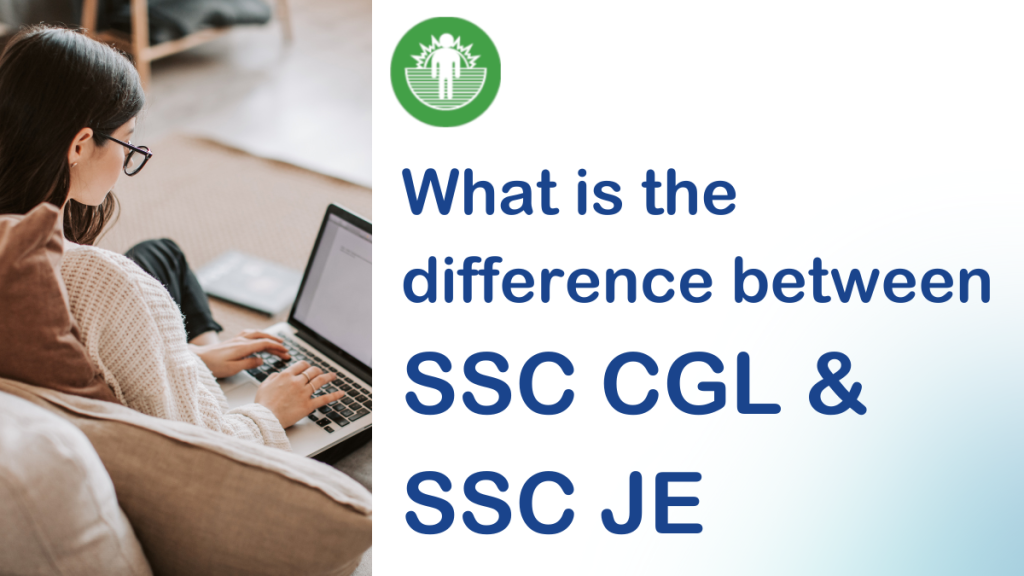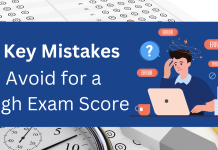In the field of government jobs in India, the Staff Selection Commission (SSC) stands as a beacon of opportunity for countless aspirants. Among the various exams conducted by the SSC, two of the most sought-after are the SSC Combined Graduate Level (CGL) and the SSC Junior Engineer (JE) exams. Both these exams open doors to prestigious government positions, but they cater to different educational backgrounds, skills, and career aspirations. In this thorough blog, we’ll explore the key differences between SSC CGL and SSC JE, helping you decide which path aligns with your goals.
Both SSC CGL and SSC JE are gateways to rewarding careers in the government sector, but they serve distinct purposes and attract different types of candidates. While SSC CGL is designed for graduates from various disciplines, offering a wide array of administrative and non-technical roles, SSC JE is specifically targeted at engineering graduates and diploma holders, focusing on technical positions in government departments. Understanding the nuances of these exams, including their eligibility criteria, exam patterns, job roles, and career growth prospects, is important for making an informed decision about which exam to pursue. Whether you aspire to be an administrative officer or a technical expert, your choice will significantly shape your future career path.

Introduction to SSC CGL and SSC JE
The SSC CGL and SSC JE exams are two of the most sought-after government job exams in India, conducted by the Staff Selection Commission (SSC). While SSC CGL is aimed at graduates seeking administrative roles across various government departments, SSC JE is customized for engineering graduates and diploma holders aspiring to technical positions. Both exams offer distinct career paths and opportunities in the public sector.
- SSC CGL: The Combined Graduate Level exam is intended for graduates across various disciplines. It offers positions in ministries, departments, and organizations of the Government of India.
- SSC JE: The Junior Engineer exam is specifically for engineering graduates and diploma holders. It recruits candidates for technical roles in various government departments.
Eligibility Criteria
The eligibility criteria for SSC CGL and SSC JE differ based on educational qualifications and age limits. For SSC CGL, candidates must hold a bachelor’s degree in any discipline from a recognized university. The age limit varies by post, typically ranging from 18 to 32 years. For SSC JE, candidates need an engineering degree or diploma in Civil, Electrical, or Mechanical Engineering, with age limits usually between 18 and 32 years.
Educational Qualifications
- SSC CGL: Candidates must hold a bachelor’s degree from a recognized university. There is no restriction on the stream, making it accessible to graduates from various backgrounds.
- SSC JE: Candidates must possess a degree or diploma in engineering. The specialization can be in Civil, Mechanical, Electrical, or other engineering disciplines, depending on the job profile.
Age Limit
- SSC CGL: The age limit for SSC CGL varies depending on the post, typically ranging from 18 to 32 years. Age relaxations are provided for reserved categories.
- SSC JE: The age limit for SSC JE also varies by department and post, generally ranging from 18 to 30 years, with similar relaxations for reserved categories.
| Criteria | SSC CGL | SSC JE |
| Educational Qualification | Bachelor’s Degree in any stream | Degree/Diploma in Engineering |
| Age Limit | 18-32 years | 18-30 years |
| Stream Specific | No | Yes (Engineering) |
Exam Pattern and Syllabus
Understanding the exam pattern and syllabus is essential for targeted preparation. SSC CGL consists of four tiers, covering subjects like General Intelligence, General Awareness, Quantitative Aptitude, and English. SSC JE, on the other hand, includes two papers—one focusing on general engineering subjects and the other on technical subjects specific to Civil, Electrical, or Mechanical Engineering. Both exams demand a strategic approach to success.
SSC CGL Exam Pattern
The SSC CGL exam consists of four tiers: Tier-I (objective test), Tier-II (objective test), Tier-III (descriptive paper), and Tier-IV (skill test/document verification):
- Tier I: Preliminary Exam (Objective Multiple Choice)
- Subjects: General Intelligence & Reasoning, General Awareness, Quantitative Aptitude, and English Comprehension.
- Marks: 200
- Tier II: Main Exam (Objective Multiple Choice)
- Subjects: Quantitative Abilities, English Language & Comprehension, Statistics, and General Studies (Finance & Economics).
- Marks: 800
- Tier III: Descriptive Paper
- Mode: Pen and Paper (Essay, Precis, Letter, Application Writing)
- Marks: 100
- Tier IV: Skill Test/Computer Proficiency Test/Data Entry Speed Test (where applicable).
SSC JE Exam Pattern
The SSC JE exam includes two papers: Paper I (objective test covering general and technical subjects) and Paper II (descriptive test focused on engineering disciplines).
Paper I: Objective Type (Computer-Based Test)
- Subjects: General Intelligence & Reasoning, General Awareness, and Engineering Discipline (Civil, Electrical, Mechanical).
- Marks: 200
Paper II: Descriptive Type (Written Exam)
- Subject: Engineering Discipline (Civil, Electrical, Mechanical).
- Marks: 300
| Tier/Paper | SSC CGL | SSC JE |
| Preliminary | General Intelligence, Quant, English, GA | General Intelligence, GA, Engineering |
| Main/Descriptive | Quant, English, Statistics, Finance | Engineering Discipline |
| Skill Test | Computer Proficiency/Data Entry | Not Applicable |
Career Prospects and Job Roles
One major difference between SSC CGL and SSC JE is the nature of the job roles. SSC CGL positions include administrative and clerical roles such as Assistant Section Officer and Inspector in various government departments. In contrast, SSC JE positions are technical, involving engineering responsibilities such as site management and project supervision in departments like Public Works or Power. Each path offers distinct career opportunities and growth potential.
SSC CGL Job Profiles
SSC CGL provides diverse job profiles, categorized into four main groups: administrative roles, auditing positions, enforcement positions, and clerical jobs, each offering unique responsibilities and career paths:
- Assistant Section Officer (ASO): Roles in various ministries and departments.
- Inspector (Central Excise, Income Tax, etc.): Field jobs involving inspection and reporting.
- Auditor/Accountant: Office-based roles in government accounts and auditing departments.
- Sub Inspector (CBI, NIA, etc.): Enforcement roles in agencies like CBI and NIA.
SSC JE Job Profiles
SSC JE recruit’s candidates for engineering roles in government departments. Key job profiles include Junior Engineer (Civil), Junior Engineer (Mechanical), Junior Engineer (Electrical), and Junior Engineer (Quantity Surveying and Contracts):
- Junior Engineer (Civil): Responsible for construction and maintenance of infrastructure.
- Junior Engineer (Mechanical): Involved in mechanical systems and maintenance.
- Junior Engineer (Electrical): Oversees electrical systems and installations.
- Junior Engineer (Quantity Surveying and Contracts): Handles cost estimation and contract management.
| Aspect | SSC CGL | SSC JE |
| Job Profiles | ASO, Inspector, Auditor, Sub Inspector | Junior Engineer in various disciplines |
| Nature of Work | Administrative, Enforcement, Auditing | Technical, Engineering |
Salary and Perks
Government jobs are renowned for their stability and attractive perks. SSC CGL positions offer a salary ranging from ₹25,500 to ₹1,51,100 per month, with benefits like HRA, DA, and medical allowances. SSC JE roles provide a salary between ₹35,400 and ₹1,12,400 per month, including technical allowances and travel perks. Both positions offer job security, thorough medical benefits, and pension schemes, enhancing their appeal:
SSC CGL Salary Structure
The salary structure for SSC CGL posts varies by group and grade. Typically, salaries range from ₹25,500 to ₹1,51,100 per month. In addition to the base salary, employees receive various perks, including House Rent Allowance (HRA), Dearness Allowance (DA), and medical benefits. The exact salary package depends on the specific post and location, enhancing the overall compensation.
SSC JE Salary Structure
SSC JE posts are classified under Level 6 of the 7th Pay Commission, offering a basic salary ranging from ₹35,400 to ₹1,12,400 per month. In addition to the base salary, SSC JE roles include technical allowances, travel allowances, and other benefits, enhancing the overall compensation. These perks make SSC JE positions financially attractive and support a comfortable standard of living for employees.
| Aspect | SSC CGL | SSC JE |
| Basic Salary | ₹25,500 – ₹1,51,100 | ₹35,400 – ₹1,12,400 |
| Allowances | HRA, DA, Medical | Technical Allowance, Travel Allowance |
Work Environment and Responsibilities
The work environment and responsibilities for SSC CGL and SSC JE positions are quite different. SSC CGL roles typically involve office-based work, including administrative tasks, data handling, and policy implementation. In contrast, SSC JE positions require technical fieldwork, such as site inspections, project management, and engineering tasks. These differences define the daily responsibilities and work settings for each job profile, catering to varied interests and skills.
SSC CGL Work Environment
SSC CGL jobs are generally office-based, emphasizing administrative tasks such as paperwork, data management, and policy implementation. The work environment is structured and hierarchical, with defined roles and responsibilities. Employees work in government offices or departments, interacting with colleagues and senior officials. The job offers stability and a routine, providing a formal setting suited for those who prefer organized work environments.
SSC JE Work Environment
SSC JE roles are more field-oriented. Engineers often work on-site, handling technical tasks like construction supervision, project management, and maintenance. The work environment can be dynamic and challenging, requiring hands-on technical skills.
| Aspect | SSC CGL | SSC JE |
| Work Environment | Office-based, administrative | Field-based, technical |
| Responsibilities | Administrative, data management | Engineering, project management |
Growth Opportunities
Career growth is a key factor in evaluating job prospects. Both SSC CGL and SSC JE roles provide significant opportunities for advancement. SSC CGL employees can rise through the ranks to higher administrative positions, such as Under Secretary or Deputy Secretary. SSC JE candidates can progress to senior engineering roles, project management positions, and departmental head roles. Both paths offer a clear career trajectory and professional development.
Promotions and Career Progression in SSC CGL
SSC CGL employees can anticipate regular promotions based on performance and experience. The typical promotional hierarchy includes progression from Assistant Section Officer to Section Officer, then to Under Secretary, and potentially up to Deputy Secretary and beyond. This structured career path allows for steady growth and increased responsibilities, offering a clear trajectory for career advancement within various government departments:
- Assistant Section Officer → Section Officer → Under Secretary → Deputy Secretary → Director.
- Inspector → Assistant Commissioner → Deputy Commissioner → Joint Commissioner → Commissioner.
Promotions and Career Progression in SSC JE
SSC JE employees have a well-defined career progression. Typically, they start as Junior Engineers and can advance to roles such as Assistant Engineer, Executive Engineer, and ultimately Chief Engineer. This progression is based on experience, performance, and seniority. Opportunities for further advancement may include managerial or supervisory positions in various engineering departments, providing a structured pathway for career development in the technical field.
- Junior Engineer → Assistant Engineer → Executive Engineer → Superintending Engineer → Chief Engineer.
- Regular departmental exams and performance appraisals play a role in promotions.
| Aspect | SSC CGL | SSC JE |
| Promotions | Regular, based on performance | Regular, based on technical expertise |
| Career Progression | Administrative hierarchy | Engineering hierarchy |
Which Exam Should You Choose?
Choosing between SSC CGL and SSC JE depends on your educational background, interests, and career aspirations. Consider these factors: SSC CGL is ideal if you have a non-engineering degree and seek administrative roles, while SSC JE is suited for engineering graduates aiming for technical positions. Reflect on your career goals, preferred job nature, and growth opportunities to make an informed decision that aligns with your skills and interests.
- Educational Background: If you have an engineering degree or diploma, SSC JE might be a more suitable option. For non-engineers, SSC CGL is the way to go.
- Job Preference: If you prefer technical roles and on-site work, SSC JE is ideal. For those inclined towards administrative and office-based jobs, SSC CGL offers diverse opportunities.
- Growth and Stability: Both exams offer stable career paths with good growth opportunities. However, the nature of the work and responsibilities are different.
- Salary Expectations: While both SSC CGL and SSC JE offer attractive salaries, SSC JE generally provides higher starting pay due to the technical nature of the job.
Conclusion
Both SSC CGL and SSC JE are prestigious exams that offer a gateway to fulfilling careers in the Indian government. The choice between the two should be based on your academic qualifications, career aspirations, and personal preferences. While SSC CGL opens doors to a wide range of administrative roles, SSC JE is customized for those with a passion for engineering and technical work. Whichever path you choose, thorough preparation, dedication, and a clear understanding of your goals will be key to your success.
So, take your time, evaluate your options, and embark on the journey that aligns with your dreams and ambitions. Whether it’s the structured environment of SSC CGL or the dynamic fieldwork of SSC JE, both roads lead to a stable and rewarding career in public service.
If you’re aiming to excel in SSC exams, look no further than ixamBee for thorough support. ixamBee offers a range of SSC CHSL online courses customized to meet your specific needs, from foundational concepts to advanced strategies. Their interactive platform provides access to high-quality study materials, expert guidance, and detailed video lectures. Additionally, ixamBee’s SSC CGL mock tests simulate the actual exam environment, helping you gauge your readiness and refine your test-taking skills. With a focus on boosting your confidence and performance, ixamBee ensures you’re well-prepared to achieve top results in your SSC MTS and SSC stenographer exams. Join ixamBee today and take a significant step toward your success!
ixamBee, specializes in providing expert guidance and resources for banking exams 2024, ensuring that you are well-prepared for the upcoming bank exams like RBI Grade B, NABARD Grade B, IBPS SO, and more. Our courses align with the bank exam calendar 2024, covering all the essential topics. With a focus on the upcoming bank jobs, our previous year papers, Beepedia, SSC CGL, SSC CHSL, SSC MTS and other mock tests are designed to help you excel in upcoming banking exams.
Also read:
How To Prepare for SSC CGL Exam?
Mistakes to avoid in SSC CGL/ SSC CHSL Exams














